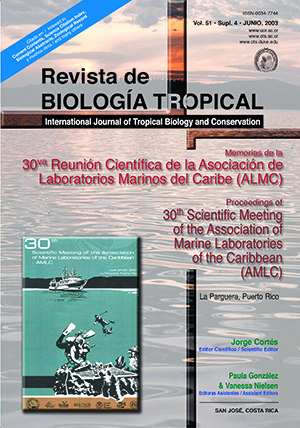Abstract
Coral patch reefs around San Salvador Island, Bahamas have been monitored with the aid of Earthwatch volunteers three times a year since 1992. During that period two significant mass bleaching events occurred: autumn 1995, and late summer 1998. Elsewhere in 1995, bleaching was caused by higher-than-normal summer sea tempera-tures; in San Salvador, however, temperatures were normal. In 1998 a prolonged period of higher-than-normal sea temperatures preceded bleaching on San Salvador and worldwide. During the 1995 event, one of the monitored reefs had twice the percentage of coral colonies bleached as the other two. Bleaching was more evenly distributed among the reefs during the 1998 event. In 1995 Agaricia agaricites was significantly more affected than other coral species, with almost 50% of all its colonies showing bleaching. Bleaching was more evenly spread among coral species in 1998, with five species showing bleaching on more than 40% of their colonies. Bleaching began on Millepora as early as August during the 1998 event and progressed to other species through the remainder of the autumn. In 1995 bleaching was not seen until late autumn and appeared to impact all affected species at about the same time. Recovery from the 1995 event was complete: no coral death or damage above normal background levels were seen. In the 1998 event, all Acropora cervicornis on the monitored reefs died and A. palmata was severely damaged. Millepora sp. lost almost half of their live tissue, and Montastraea sp. showed significant tissue damage following this event. Phototransect analysis suggests that more than 20% of total live tissue on affected species died during the 1998 event. A. cervicornis has demonstrated no re-growth from 1998 to 2000 on monitored reefs. Monitoring has suggested sig-nificant differences in causes and courses in these two events.References
Aronson, R.B., W.F. Precht, I.G. Macintyre & T.J.T. Murdoch. 2000. Coral bleach-out in Belize. Nature 405: 36.
Atwood, D.K., J.C. Hendee & A. Mendez. 1992. An assessment of global warming stress on Caribbean coral reef ecosystems. Bull. Mar. Sci. 51: 118-130.
Burke, C. 1997. Abstract on Belize bleaching. NOAA. (Downloaded: January 23, 1997. http://coral.aoml.noaa. gov/archive/champ/list-archives/coral-list-1997.txt).
Fitt, W.K. & M.E. Warner. 1995. Bleaching patterns of four species of Caribbean reef corals. Biol. Bull. 189: 298-307.
Gleason, D.F. & G.M. Wellington. 1993. Ultraviolet radiation and coral bleaching. Nature 365: 836-838.
Greenstein, B.J., H.A. Curran & J.M. Pandolfi. 1998. Shifting ecological baselines and the demise of Acropora cervicornis in the western North Atlantic and Caribbean Province: a Pleistocene perspective. Coral Reefs 17: 249-261.
Harriott, V.J. 1985. Mortality rates of scleractinian corals before and during a mass bleaching event. Mar. Ecol. Prog. Ser. 21: 81-85.
Holden, C. 2000. Coral yields antisunburn secret. Science 287: 1743.
Kerr, R.A. 1993. Pinatubo global cooling on target. Science 259: 594.
Lang, J.C., H.R. Lasker, E.H. Gladfelter, P. Hallock, W.C. Jaap, F.J. Losada & R.G. Muller. 1992. Spatial and temporal variability during periods of "recovery" after mass bleaching on Western Atlantic coral reefs. Amer. Zool. 32: 696-706.
McField, M. 1995. A bleaching update: Belize. NOAA. (Downloaded: October 30, 1995. http://coral.aoml. noaa.gov/archive/champ/list-archives/coral-list-1995. txt).
McGrath, T.A. 1992. Long-term study of coral bleaching events on the reefs of San Salvador Island, Bahamas, p. 83-89. In W.H. Eshbaugh (ed.). Proc. of the 4th Symp. on the Nat. His. Bahamas. Bahamian Field Station..
McGrath, T.A., D.T. Gerace & G.W. Smith. 1994. Monitoring the patch reefs of San Salvador, Bahamas for changes due to bleaching and disease, p. 147-156. In D.T. Gerace (ed.). Proc. 26th Assoc. Marine Lab. Caribbean. San Salvador, Bahamas, Bahamian Field Station.
McGrath, T.A. & G.W.Smith. 1998. The effects of the 1995/1996 Western Atlantic coral bleaching event on the patch reefs around San Salvador Island, Bahamas. Rev. Biol. Trop. 46: 91-100.
McGrath, T.A. & G.W. Smith. 1999. Monitoring the coral patch reefs of San Salvador Island, Bahamas, In G.W. Smith (ed.). Proc. 8th Symp. Nat. Hist. Bahamas, Bahamian Field Station.
Normile, D. 2000. Warmer waters more deadly to reefs than pollution. Science 290: 682-683.
Ostrander, G., K.M. Armstrong, T. Knobbe, D. Gerace & E.P Scully. 2000. Rapid transition in the structure of a coral reef community: The effects of coral bleaching and physical disturbance. Proc. Ntl. Acad. Sci. 97: 5297-5302.
Rodriguez, R.E. 1996. Re: bleachings and spawnings. (Downloaded: October 29, 1996. http://coral.aoml. noaa.gov/archive/champ/list-archives/coral-list-1996. txt).
Schweitzer, P. N. 1993. Modern average global seasurface temperatures. U.S. Geological Survey Digital Data Series DDS-10, U.S. Department of the Interior (compact disk).
Ware, J. A. 1995. Bonaire bleaching. Online archive. (Downloaded: November 27, 1995. http://coral.aoml. noaa.gov/archive/champ/list-archives/coral-list-1995. txt).
Williams, E.H. & L. Bunkley-Williams. 1990. The worldwide coral reef bleaching cycle and related sources of coral mortality. Atoll Res. Bull. 335: 1-72.
Comments

This work is licensed under a Creative Commons Attribution 4.0 International License.
Copyright (c) 2003 Revista de Biología Tropical


